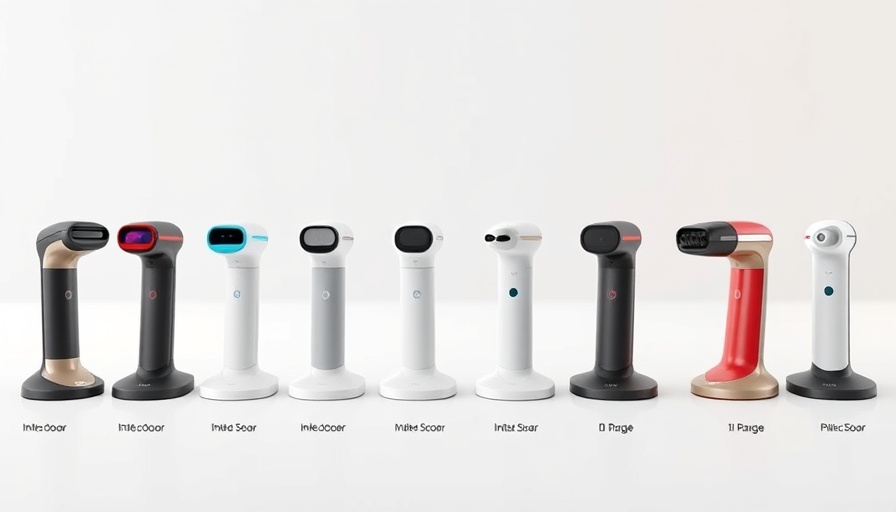
Understanding Intraoral Scanners: A Necessary Investment for Your Practice
Intraoral scanners (IOS) have transformed the way dental professionals capture digital impressions, moving away from traditional methods that often involve uncomfortable materials for patients. As the intraoral scanner market continues to mature, the competitive landscape has broadened, compelling dental practitioners to assess various options based on functionality, pricing, and overall performance. This article focuses on an in-depth comparison of five key intraoral scanners: Alliedstar’s AS 100, AS 200E, and AS 260, along with SHINING 3D’s Aoralscan 3 Wireless and Dentsply Sirona’s CEREC Primescan.
Comparative Overview of Alliedstar's Intraoral Scanners
The Alliedstar series comprises three notable scanners, each tailored to meet different practice needs:
- Alliedstar AS 100: Positioned as the entry-level model, the AS 100 is now discontinued but offers insights into older technology versus modern capabilities. Priced affordably at approximately $5,000, it features a modest weight of 198g and operates with STL and PLY file formats. This model is beneficial for practices new to digital dentistry looking for cost-effective solutions.
- Alliedstar AS 200E: As an improved version of the AS 100, priced at $8,995, this scanner weighs 175g and supports the same file formats. It brings ergonomic enhancements that make scanning easier and more comfortable for both the dentist and the patient, representing a significant upgrade.
- Alliedstar AS 260: The AS 260 stands out as a wireless option and operates on one of the most advanced platforms available within Alliedstar’s offerings. This model, priced at $11,995 and weighing 245g (including battery), provides ease of movement during procedures — an essential feature in the dynamic environment of dental practice.
Analyzing the SHINING 3D Aoralscan 3 Wireless
The SHINING 3D Aoralscan 3 Wireless represents a pivotal innovation in intraoral scanning technology. As the company's second wireless scanner, it emphasizes flexibility and efficiency, providing an optimal scanning experience while minimizing patient discomfort. Its ability to seamlessly interface with various digital platforms elevates its usability in diverse dental environments.
Assessing the Dentsply Sirona CEREC Primescan's Advantages
The CEREC Primescan is one of the market leaders in the intraoral scanning arena. Renowned for its high-resolution imaging, the Primescan offers unparalleled precision, enabling practitioners to create more accurate restorations. Moreover, its intuitive user interface and powerful software integrations make it a firm favorite among seasoned and new practitioners alike.
Key Factors to Consider When Choosing an Intraoral Scanner
When evaluating which intraoral scanner to incorporate into your practice, several factors warrant consideration:
- Cost: Determine the value proportional to your budget constraints. Entry-level options may serve initial needs but consider long-term functionality against the investment.
- Ergonomics: A scanner that is easy to handle can significantly enhance the scanning experience for both dentist and patient.
- Software and Platform Compatibility: Assess how well each scanner integrates with your existing software and digital tools; interoperability is crucial for an efficient digital workflow.
- Patient Comfort: Less intrusive scanning methods enhance patient satisfaction and compliance; choose devices that minimize discomfort.
- Training and Support: Consider the manufacturer's training capabilities and ongoing support to maximize the benefits of your investment.
Looking Ahead: Future Trends in Intraoral Scanning Technology
As dental technology continues to evolve, we can expect new advancements in intraoral scanners that enhance both efficiency and patient experiences. Emerging trends may include improved AI algorithms for real-time data processing, advanced imaging capabilities that produce higher contrast and resolution, and even heightened wireless functionalities that could facilitate greater autonomy in scanning procedures.
Conclusion: Making an Informed Decision for Your Practice
In summary, selecting the right intraoral scanner requires careful consideration of several factors, including cost, functionality, and user experience. As the competition between Alliedstar, SHINING 3D, and CEREC intensifies, staying informed about these developments will empower practitioners like Dr. Emily Johnson to make informed choices that align with their practice’s operational goals. Stay engaged with the latest technology while simplifying the path to superior patient care.
 Add Row
Add Row  Add
Add 




Write A Comment